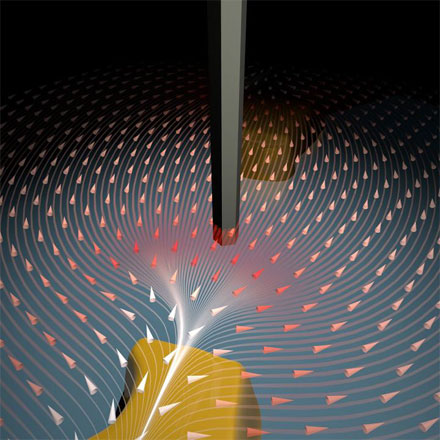BASEL and LAUSANNE, Switzerland, Oct. 28, 2016 — An atomic force microscope (AFM) that uses nanowires as sensors has demonstrated the ability to measure force size as well as force direction.
Due to slight asymmetries in geometry, a nanowire's flexural modes are split into doublets vibrating along orthogonal axes at nearly the same frequency. When the nanowires are integrated into an AFM, the changes in the vibrations caused by different forces can be measured. Essentially, the nanowires can be used as tiny mechanical “compasses” that point out both the direction and size of the surrounding forces.
 To show how nanowires could be used as force sensors in AFMs, researchers from the University of Basel and Swiss Federal Institute of Technology Lausanne used a nanowire sensor to image a patterned sample surface. They monitored the frequency shift and direction of oscillation of both modes of the nanowires while they scanned above the surface, and constructed a map of all spatial tip-sample force derivatives in the plane using their nanowire “compass.” As proof-of-principle, the nanowire was used to image electric force fields, distinguishing between forces arising from the nanowire charge and polarizability.
To show how nanowires could be used as force sensors in AFMs, researchers from the University of Basel and Swiss Federal Institute of Technology Lausanne used a nanowire sensor to image a patterned sample surface. They monitored the frequency shift and direction of oscillation of both modes of the nanowires while they scanned above the surface, and constructed a map of all spatial tip-sample force derivatives in the plane using their nanowire “compass.” As proof-of-principle, the nanowire was used to image electric force fields, distinguishing between forces arising from the nanowire charge and polarizability.
The most challenging technical aspect of the experiment was the construction of a device that could simultaneously scan a nanowire above a surface and monitor its vibration along two perpendicular directions.
A nanowire sensor measures size and direction of forces. Courtesy of University of Basel, Department of Physics.
With this study, the researchers have demonstrated a novel type of AFM that could extend the numerous applications for atomic force microscopy even further. For example, it may enable a form of atomic force microscopy suitable for mapping the size and direction of weak tip-sample forces.
Standard types of AFM often use cantilevers made from crystalline Si as the mechanical sensor. "Moving to much smaller nanowire sensors may now allow for even further improvements on an already amazingly successful technique," said professor Martino Poggio.
Because of their surface area-to-volume ratio, small mass, and impeccable crystal lattice, nanowires are seen as useful for a variety of nanometer-scale sensing applications, including as sensors of biological and chemical samples and as pressure or charge sensors.
The research was published in Nature Nanotechnology (doi:10.1038/nnano.2016.189).